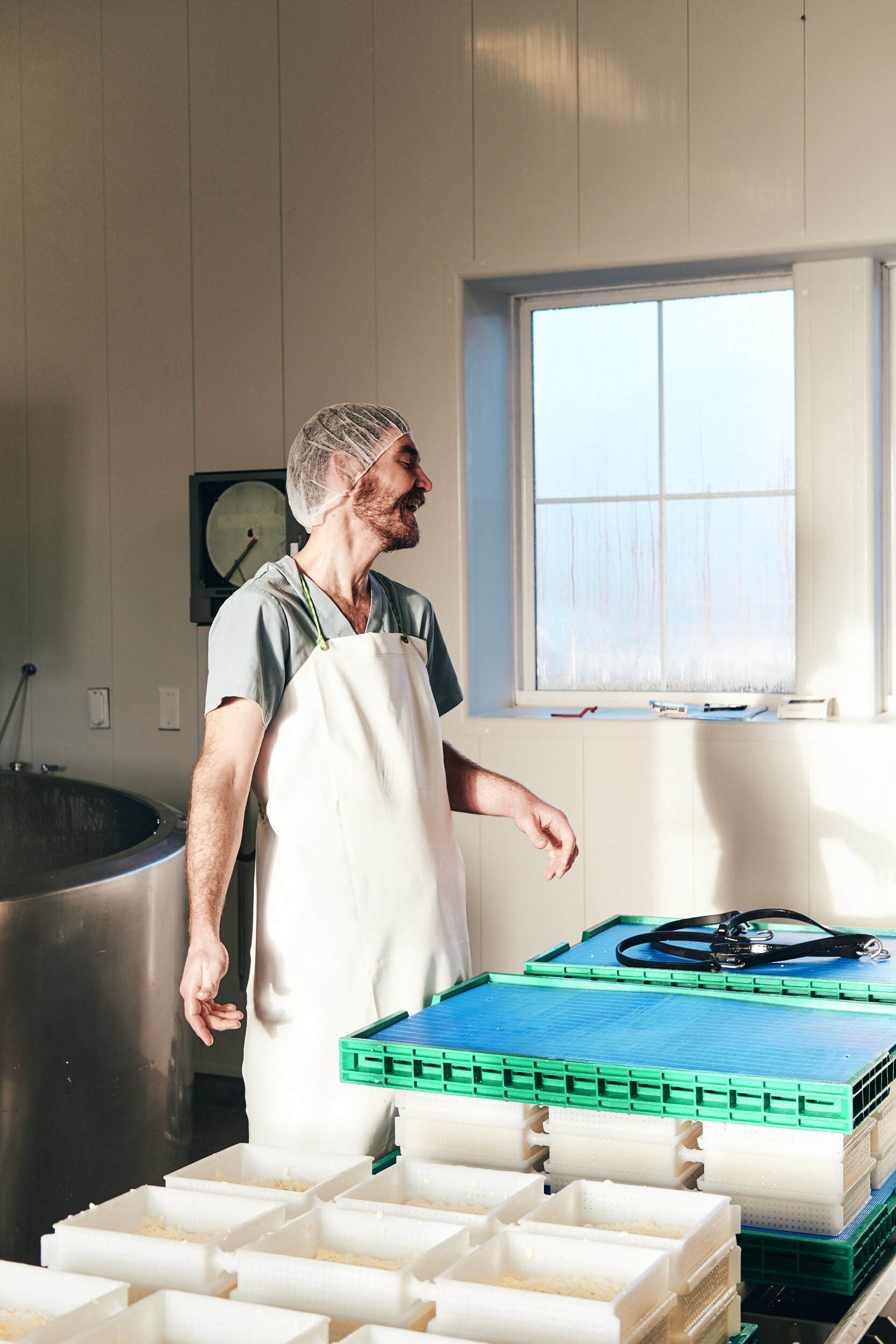On Cheesemaking
On Cheesemaking
Cheesemaking is not an easy sport. It takes weeks, if not months, to culture, cut, hoop, and age our cheeses. As much a science as an art, cheesemaking takes a precise command of craft – and an immense amount of patience – to turn a few gallons of milk into a few ounces of Grey Barn certified organic cheese.
OUR PROCESS
The first steps
At The Grey Barn, cheesemaking begins when we pump milk from the bulk tank in our parlor into our stainless steel cheesemaking vat, which is capable of processing hundreds of gallons of milk at a time. The vat slowly warms the milk as we introduce a mixture of salt, culture, and rennet that is unique to each cheese we make.
The culture (or cultures) we introduce at this early stage determines the defining characteristics of the cheese. Different cheese cultures each hold a storied tradition in the world of cheesemaking – for example, the famous Penicillium gives blue cheese its distinctive navy veins. Starter cultures largely dictate how a cheese is handled (i.e., how it’s cut, drained, salted, and aged) lest the bacteria not develop the proper flavor and texture within the cheese.
Rennet, also introduced in this early stage, is the unsung hero of cheesemaking. An enzyme originally native to the stomach of calves and lambs, rennet helps young animals separate out milk’s fatty solids from the excess fluid. In cheesemaking, rennet activates in warm milk and separates the salt, culture, and milk solids (called the “curd”) from their watery base (“whey”).
Cutting curd
Once the rennet has fully activated, large, spinning cheese knives – dangerous, but not as cool as they sound – begin to rotate through the vat. They slice the curd, which naturally floats above the whey. The size to which cheesemakers cut the curd (from golf ball to oyster cracker) can make-or-break the cheese’s final texture. The soft, sponge-like curd is scooped out of the vat and poured into molds that roughly resemble a cheese’s final shape. The cheese will lose a lot of weight before it’s wrapped up and shipped out.
Affinage
Once in its mold, the cheese is flipped, drained, and pressed until it has enough internal structure to stand on its own. This can take anywhere from a few hours to a few days, depending on the size of the cheese. The cheeses are often brined in salt water. From here, the cheese moves into the cheese-caves, large, cool rooms, where the bacteria ramp up their metabolism and begin to develop specific flavors of the curd. While the affineurs of Switzerland may age their giant wheels in the caverns of the Alps, our cheese-caves look more like giant walk-in refrigerators.
Perhaps the most varied step in cheesemaking is the aging process – affinage. Cheese are often categorized by their aging process: Large blue cheeses sit in dry, cool storage for months, watched carefully to ensure that the signature blue veins develop and the rind properly hardens. The bacteria in bloomy-rind cheeses puffs up like bread mold, and cheesemakers pat it down every few days to develop the bitter rind. In washed-rind cheeses, the exterior is scrubbed with culture and saltwater to ensure a strong and colorful finish.
The finishing touches
We pull and wrap our cheeses just days before they reach their peak. Our wrapping paper – designed full of microscopic pores specifically so that the cheese can breathe – allows the internal culture to respire and continue the aging process. By the time the cheese reaches your grocery bag or dinner plate, it’s at its intended prime. If you prefer your cheese a little stinkier… leave it wrapped up in the back of the fridge, and you’ll be surprised by what you find later.
A CREAMERY HISTORY
Farm owner Molly began making The Grey Barn’s certified organic cheese in the spring of 2011. Although it started with just the washed-rind Prufrock and bloomy-rind Eidolon, the suite of Grey Barn cheeses has evolved, with much thanks to our Master Cheesemaker Joe. It now includes two blues (Bluebird and Bluebird Reserve), a raw-milk alpine (RipRap), and a large-format washed-rind (Bon Anniversaire). This last cheese was developed to celebrate the farm’s tenth anniversary.
Cheesemaking takes an intuitive knowledge of milk and time. You must love this work – it requires that you rise in the early morning and stay late into the evening. You build, develop, and protect your cheese before wrapping it up and shipping it off to the world. The real joy of cheesemaking is the smile when someone says, “Oh, you make my favorite cheese?” It’s all a labor of love.
BUILDING CHEESES
We don’t use cookbooks to develop our cheeses. More like architects than chefs, fine cheesemakers use their knowledge of traditional techniques in tandem with modern technology to provide a cohesive sensory experience. We research cheese, diving in on flavors and textures we like and constantly work to perfect our craft. Each cheese is a patchwork of what we love, and we hope you’ll enjoy it too.








